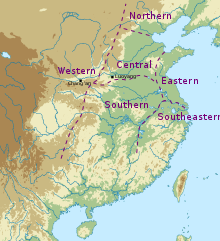Fangyan
The Fāngyán (Chinese: 方言), compiled by the Han dynasty poet and philosopher Yang Xiong (53 BCE – 18 CE), was the first Chinese dictionary of regionalisms. Translations of this ancient dictionary's title include: 'regional words',[1] 'regional expressions',[2] 'dictionary of local expressions',[3] and 'regional spoken words'.[4][lower-alpha 1]
| Fangyan | |||||||||||||||||||||||||||
|---|---|---|---|---|---|---|---|---|---|---|---|---|---|---|---|---|---|---|---|---|---|---|---|---|---|---|---|
| Chinese | 方言 | ||||||||||||||||||||||||||
| Literal meaning | "Regional Speech" | ||||||||||||||||||||||||||
| |||||||||||||||||||||||||||
Yang Xiong's Fangyan is considered the "most significant lexicographic work" of the Western Han.[5] His dictionary's preface explains how he spent 27 years amassing and collating the dictionary. Yang collected regionalisms from many sources, particularly the yóuxuān (輶軒 'light carriage') surveys, which were a Zhou and Qin dynasty tradition of annually sending imperial emissaries into the countryside to gather folk songs and popular sayings, which recorded localisms from all over China and as far north as Korea.[5] The Fangyan's full title is Yóuxuān shǐzhĕ juédài yǔ shì biéguó fāngyán (輶軒使者絕代語釋別國方言, 'Local expressions of other countries in times immemorial explained by the Light-Carriage Messenger').
Contents

Fangyan originally contained some 9,000 characters in 15 chapters (卷), but two chapters were subsequently lost.
Definitions typically list regional synonyms. For instance, chapter 8, which catalogs animal names, gives regional words for hu (虎 'tiger') in Han times.
虎, 陳魏宋楚之間或謂之李父, 江淮南楚之間謂之李耳, 或謂之於菟. 自關東西或謂之伯都.
"Tiger: in the regions of Chen-Wei Song-Chu [Central China], some call it lifu; in the regions of Jiang-Huai Nan-Chu [Southern China], they call it li'er, and some call it wutu. From the Pass, east- and west-ward [Eastern and Western China], some call it also bodu."[6]
Comparative linguists have used dialect data from the Fangyan in reconstructing the pronunciation of Eastern Han Chinese (1st century CE), which is an important diachronic stage between Old Chinese and Middle Chinese. In the above example, Paul Serruys reconstructs "tiger" as Old Chinese *blxâg.
Serruys also applied the techniques of modern dialectology to the distribution of regional words, identifying dialect areas and their relationships.
Notes
- In modern usage, the term fāngyán is customarily translated as English dialect, but linguists have proposed direct neologisms of regionalect (John DeFrancis) and topolect (Victor Mair).
References
- Knechtges, David R.; Chang, Taiping, eds. (2014). Ancient and Early Medieval Chinese Literature. A Reference Guide. Part Three. Leiden/Boston: Brill. p. 1935.
- Yao, Xinzhong, ed. (2015). The Encyclopedia of Confucianism. Routledge. p. 472.
- Needham, Joseph; Ronan, Colin A., eds. (1978), The Shorter Science and Civilisation in China, Cambridge: Cambridge University Press, p. 118
- O’Neill, Timothy Michael (2016). Ideography and Chinese Language Theory: A History. Berlin/Boston: de Gruyter. p. 206.
- Creamer 1992, p. 113.
- Serruys 1967, p. 256.
- Creamer, Thomas B. I. (1992). "Lexicography and the history of the Chinese language". In Zgusta, Ladislav (ed.). History, Languages, and Lexicographers. Lexicographica Series. maior 41. Niemeyer. p. 105-135.CS1 maint: ref=harv (link)
- DeFrancis, John (1984). The Chinese Language: Fact and Fantasy. University of Hawaii Press.
- Groves, Julie M. (2008). "Language or Dialect – or Topolect? A Comparison of the Attitudes of Hong Kongers and Mainland Chinese towards the Status of Cantonese" (PDF). Sino-Platonic Papers. 179: 1–103.CS1 maint: ref=harv (link)
- Mair, Victor H. (1991). "What Is a Chinese "Dialect/Topolect"? Reflections on Some Key Sino-English Linguistic terms" (PDF). Sino-Platonic Papers. 29: 1–31. Archived from the original (PDF) on 2018-05-10.CS1 maint: ref=harv (link)
- Serruys, Paul L-M. (1959). The Chinese Dialects of Han Time According to Fang Yen. Berkeley: University of California Press.CS1 maint: ref=harv (link)
- Serruys, Paul L-M. (1967). "Five Word Studies on Fang Yen (Third Part): The Dialect Words for 'Tiger'". Monumenta Serica. 26 (1): 255–285. doi:10.1080/02549948.1967.11744969.CS1 maint: ref=harv (link)
Further reading
- Gina Anne Tam. 2020. Dialect and Nationalism in China, 1860–1960. Cambridge University Press.
External links
| Chinese Wikisource has original text related to this article: |
- Fangyan 方言, Chinaknowledge
- 方言, text in Chinese at CText
- 方言: 13卷 (粤東書局) 1873 on Google Books
- 方言 at the Internet Archive